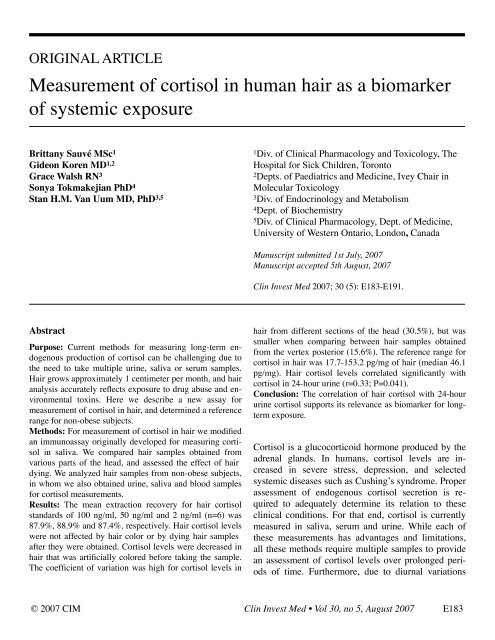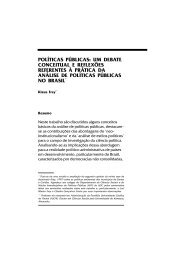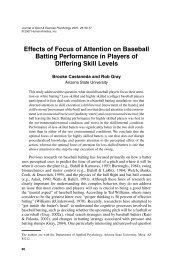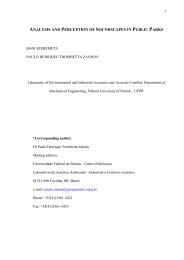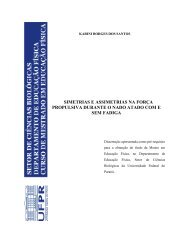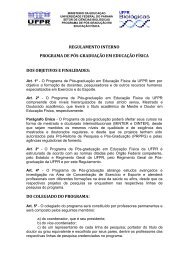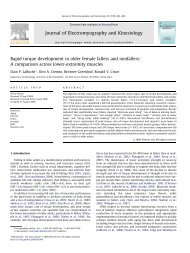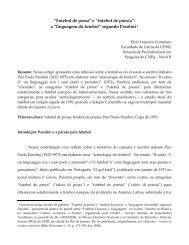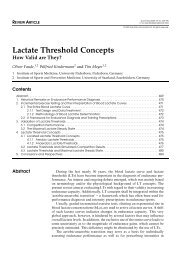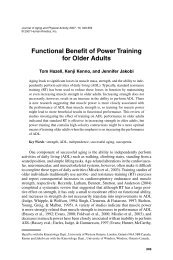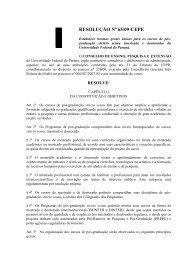Measurement of cortisol in human hair as a biomarker of ... - UFPR
Measurement of cortisol in human hair as a biomarker of ... - UFPR
Measurement of cortisol in human hair as a biomarker of ... - UFPR
You also want an ePaper? Increase the reach of your titles
YUMPU automatically turns print PDFs into web optimized ePapers that Google loves.
ORIGINAL ARTICLE<br />
<strong>Me<strong>as</strong>urement</strong> <strong>of</strong> <strong>cortisol</strong> <strong>in</strong> <strong>human</strong> <strong>hair</strong> <strong>as</strong> a <strong>biomarker</strong><br />
<strong>of</strong> systemic exposure<br />
Brittany Sauvé MSc 1<br />
Gideon Koren MD 1,2<br />
Grace Walsh RN 3<br />
Sonya Tokmakejian PhD 4<br />
Stan H.M. Van Uum MD, PhD 3,5<br />
1 Div. <strong>of</strong> Cl<strong>in</strong>ical Pharmacology and Toxicology, The<br />
Hospital for Sick Children, Toronto<br />
2 Depts. <strong>of</strong> Paediatrics and Medic<strong>in</strong>e, Ivey C<strong>hair</strong> <strong>in</strong><br />
Molecular Toxicology<br />
3 Div. <strong>of</strong> Endocr<strong>in</strong>ology and Metabolism<br />
4 Dept. <strong>of</strong> Biochemistry<br />
5 Div. <strong>of</strong> Cl<strong>in</strong>ical Pharmacology, Dept. <strong>of</strong> Medic<strong>in</strong>e,<br />
University <strong>of</strong> Western Ontario, London, Canada<br />
Manuscript submitted 1st July, 2007<br />
Manuscript accepted 5th August, 2007<br />
Cl<strong>in</strong> Invest Med 2007; 30 (5): E183-E191.<br />
Abstract<br />
Purpose: Current methods for me<strong>as</strong>ur<strong>in</strong>g long-term endogenous<br />
production <strong>of</strong> <strong>cortisol</strong> can be challeng<strong>in</strong>g due to<br />
the need to take multiple ur<strong>in</strong>e, saliva or serum samples.<br />
Hair grows approximately 1 centimeter per month, and <strong>hair</strong><br />
analysis accurately reflects exposure to drug abuse and environmental<br />
tox<strong>in</strong>s. Here we describe a new <strong>as</strong>say for<br />
me<strong>as</strong>urement <strong>of</strong> <strong>cortisol</strong> <strong>in</strong> <strong>hair</strong>, and determ<strong>in</strong>ed a reference<br />
range for non-obese subjects.<br />
Methods: For me<strong>as</strong>urement <strong>of</strong> <strong>cortisol</strong> <strong>in</strong> <strong>hair</strong> we modified<br />
an immuno<strong>as</strong>say orig<strong>in</strong>ally developed for me<strong>as</strong>ur<strong>in</strong>g <strong>cortisol</strong><br />
<strong>in</strong> saliva. We compared <strong>hair</strong> samples obta<strong>in</strong>ed from<br />
various parts <strong>of</strong> the head, and <strong>as</strong>sessed the effect <strong>of</strong> <strong>hair</strong><br />
dy<strong>in</strong>g. We analyzed <strong>hair</strong> samples from non-obese subjects,<br />
<strong>in</strong> whom we also obta<strong>in</strong>ed ur<strong>in</strong>e, saliva and blood samples<br />
for <strong>cortisol</strong> me<strong>as</strong>urements.<br />
Results: The mean extraction recovery for <strong>hair</strong> <strong>cortisol</strong><br />
standards <strong>of</strong> 100 ng/ml, 50 ng/ml and 2 ng/ml (n=6) w<strong>as</strong><br />
87.9%, 88.9% and 87.4%, respectively. Hair <strong>cortisol</strong> levels<br />
were not affected by <strong>hair</strong> color or by dy<strong>in</strong>g <strong>hair</strong> samples<br />
after they were obta<strong>in</strong>ed. Cortisol levels were decre<strong>as</strong>ed <strong>in</strong><br />
<strong>hair</strong> that w<strong>as</strong> artificially colored before tak<strong>in</strong>g the sample.<br />
The coefficient <strong>of</strong> variation w<strong>as</strong> high for <strong>cortisol</strong> levels <strong>in</strong><br />
<strong>hair</strong> from different sections <strong>of</strong> the head (30.5%), but w<strong>as</strong><br />
smaller when compar<strong>in</strong>g between <strong>hair</strong> samples obta<strong>in</strong>ed<br />
from the vertex posterior (15.6%). The reference range for<br />
<strong>cortisol</strong> <strong>in</strong> <strong>hair</strong> w<strong>as</strong> 17.7-153.2 pg/mg <strong>of</strong> <strong>hair</strong> (median 46.1<br />
pg/mg). Hair <strong>cortisol</strong> levels correlated significantly with<br />
<strong>cortisol</strong> <strong>in</strong> 24-hour ur<strong>in</strong>e (r=0.33; P=0.041).<br />
Conclusion: The correlation <strong>of</strong> <strong>hair</strong> <strong>cortisol</strong> with 24-hour<br />
ur<strong>in</strong>e <strong>cortisol</strong> supports its relevance <strong>as</strong> <strong>biomarker</strong> for longterm<br />
exposure.<br />
Cortisol is a glucocorticoid hormone produced by the<br />
adrenal glands. In <strong>human</strong>s, <strong>cortisol</strong> levels are <strong>in</strong>cre<strong>as</strong>ed<br />
<strong>in</strong> severe stress, depression, and selected<br />
systemic dise<strong>as</strong>es such <strong>as</strong> Cush<strong>in</strong>g’s syndrome. Proper<br />
<strong>as</strong>sessment <strong>of</strong> endogenous <strong>cortisol</strong> secretion is required<br />
to adequately determ<strong>in</strong>e its relation to these<br />
cl<strong>in</strong>ical conditions. For that end, <strong>cortisol</strong> is currently<br />
me<strong>as</strong>ured <strong>in</strong> saliva, serum and ur<strong>in</strong>e. While each <strong>of</strong><br />
these me<strong>as</strong>urements h<strong>as</strong> advantages and limitations,<br />
all these methods require multiple samples to provide<br />
an <strong>as</strong>sessment <strong>of</strong> <strong>cortisol</strong> levels over prolonged periods<br />
<strong>of</strong> time. Furthermore, due to diurnal variations<br />
© 2007 CIM Cl<strong>in</strong> Invest Med • Vol 30, no 5, August 2007 E183
Sauvé et al. <strong>Me<strong>as</strong>urement</strong> <strong>of</strong> <strong>cortisol</strong> <strong>in</strong> <strong>hair</strong><br />
samples either need to be taken at specific times <strong>of</strong> the<br />
day (saliva and serum), or require a laborious collection<br />
method (24 hr ur<strong>in</strong>e collection), mak<strong>in</strong>g them unsuitable<br />
for population analysis. 1 Even 24-hr ur<strong>in</strong>e<br />
collection reflects the l<strong>as</strong>t day and not changes that<br />
can occur over weeks to months.<br />
Hair analysis is <strong>in</strong>cre<strong>as</strong><strong>in</strong>gly used to reflect exposure<br />
to drugs <strong>of</strong> abuse and environmental tox<strong>in</strong>s. 2 Incorporation<br />
<strong>of</strong> hormones <strong>in</strong> <strong>hair</strong> is thought to occur<br />
ma<strong>in</strong>ly via blood circulation dur<strong>in</strong>g the formation <strong>of</strong><br />
the <strong>hair</strong> shaft. 3 Because <strong>of</strong> the balance exist<strong>in</strong>g between<br />
serum levels and <strong>hair</strong> concentration, me<strong>as</strong>urement<br />
<strong>of</strong> endogenously produced hormonal levels <strong>in</strong><br />
<strong>hair</strong> may reflect average hormone levels over months.<br />
Specifically, because <strong>hair</strong> grows approximately 1 centimeter<br />
per month (range 0.6-1.4 cm) 4 , a <strong>hair</strong> sample<br />
<strong>of</strong> 2-3 cm reflects average hormone levels over the<br />
previous 2-3 months. Hence, unlike other matrices,<br />
<strong>hair</strong> <strong>cortisol</strong> may represent long-term exposure to the<br />
hormone.<br />
Dur<strong>in</strong>g the l<strong>as</strong>t few years, the Str<strong>as</strong>bourg group<br />
h<strong>as</strong> reported me<strong>as</strong>urement <strong>of</strong> <strong>cortisol</strong> <strong>in</strong> <strong>human</strong> <strong>hair</strong>. 5,6<br />
Until now, no studies have contr<strong>as</strong>ted <strong>cortisol</strong> levels <strong>in</strong><br />
<strong>hair</strong> with me<strong>as</strong>urements <strong>of</strong> <strong>cortisol</strong> <strong>in</strong> saliva, serum<br />
and/or ur<strong>in</strong>e <strong>cortisol</strong> with<strong>in</strong> the same <strong>in</strong>dividuals. The<br />
objective <strong>of</strong> the present study w<strong>as</strong> to develop an <strong>as</strong>say<br />
for me<strong>as</strong>ur<strong>in</strong>g <strong>cortisol</strong> <strong>in</strong> <strong>hair</strong>, to determ<strong>in</strong>e a reference<br />
range for <strong>cortisol</strong> <strong>in</strong> <strong>hair</strong> <strong>in</strong> a non-obese control population,<br />
and to correlate these novel me<strong>as</strong>ures with <strong>cortisol</strong><br />
levels <strong>in</strong> serum, saliva and 24-hour ur<strong>in</strong>e.<br />
Methods<br />
A) Evaluation <strong>of</strong> ELISA <strong>as</strong>say for <strong>hair</strong> <strong>cortisol</strong><br />
The study w<strong>as</strong> approved by the Research Ethics Board<br />
<strong>of</strong> the University <strong>of</strong> Western Ontario, and written <strong>in</strong>formed<br />
consent w<strong>as</strong> obta<strong>in</strong>ed from all subjects prior to<br />
participation.<br />
Hair collection<br />
Hair samples consist<strong>in</strong>g <strong>of</strong> approximately 150 strands<br />
<strong>of</strong> <strong>hair</strong> or approximately 20 mg, were collected from<br />
the posterior vertex. The <strong>hair</strong> w<strong>as</strong> cut with scissors <strong>as</strong><br />
close to the scalp <strong>as</strong> possible. The <strong>hair</strong> w<strong>as</strong> then taped<br />
to a piece <strong>of</strong> paper us<strong>in</strong>g Scotch®Tape, the scalp end<br />
w<strong>as</strong> clearly marked and the sample w<strong>as</strong> stored <strong>in</strong> an<br />
envelope <strong>in</strong> room temperature up to 12 months before<br />
analysis.<br />
Hair sample preparation<br />
Samples were prepared us<strong>in</strong>g methods that have been<br />
previously reported by our lab (Yamada et al, 7 ). A<br />
m<strong>in</strong>imum <strong>of</strong> 10 mg <strong>of</strong> <strong>hair</strong> from the scalp end w<strong>as</strong><br />
used for each sample. The <strong>hair</strong> w<strong>as</strong> weighed, cut <strong>in</strong>to<br />
small pieces us<strong>in</strong>g small surgical scissors, put <strong>in</strong>to a<br />
disposable gl<strong>as</strong>s sc<strong>in</strong>tillation vial and 1 ml <strong>of</strong> methanol<br />
w<strong>as</strong> added. The sc<strong>in</strong>tillation vial w<strong>as</strong> sealed and<br />
<strong>in</strong>cubated overnight (~16 hr) at 52 °C while shak<strong>in</strong>g<br />
(Gyromax® Amerex Instruments Inc.). After <strong>in</strong>cubation,<br />
the supernatant w<strong>as</strong> removed and put <strong>in</strong>to disposable<br />
gl<strong>as</strong>s culture tubes. The supernatant w<strong>as</strong><br />
evaporated <strong>in</strong> a dry bath (Thermolyne® Dri-Bath) under<br />
nitrogen (Techne® Sample Concentrator) until<br />
completely dry. Once the methanol w<strong>as</strong> removed, the<br />
sample w<strong>as</strong> resuspended <strong>in</strong> 150-250 μL <strong>of</strong> phosphate<br />
buffered sal<strong>in</strong>e (PBS) at pH 8.0. Samples were vortexed<br />
for one m<strong>in</strong>ute followed by another 30 seconds<br />
until they were well mixed.<br />
Hair <strong>cortisol</strong> analysis<br />
The <strong>cortisol</strong> <strong>in</strong> the <strong>hair</strong> samples w<strong>as</strong> me<strong>as</strong>ured us<strong>in</strong>g<br />
the Salivary ELISA Cortisol kit© (Alpco Diagnostics®,<br />
W<strong>in</strong>dham, NH) <strong>as</strong> per the manufacturer’s directions<br />
with the reagents provided. The cross reactivity<br />
<strong>of</strong> other steroids with the kit’s antibodies w<strong>as</strong> reported<br />
<strong>as</strong> follows: corticosterone 31%, progesterone
Sauvé et al. <strong>Me<strong>as</strong>urement</strong> <strong>of</strong> <strong>cortisol</strong> <strong>in</strong> <strong>hair</strong><br />
one with a high <strong>cortisol</strong> level (about 600 pg/mg), to<br />
determ<strong>in</strong>e both the <strong>in</strong>tra-<strong>as</strong>say and <strong>in</strong>terday variation<br />
<strong>of</strong> <strong>hair</strong> <strong>cortisol</strong> me<strong>as</strong>urement.<br />
Effects <strong>of</strong> natural <strong>hair</strong> color on <strong>cortisol</strong> levels. To determ<strong>in</strong>e<br />
if <strong>hair</strong> matrix affects <strong>cortisol</strong> detection on the<br />
ELISA, <strong>hair</strong> from 4 brown, 4 blond, and 4 black<br />
<strong>hair</strong>ed volunteers w<strong>as</strong> collected. Each subject’s <strong>hair</strong><br />
w<strong>as</strong> f<strong>in</strong>ely chopped to create a homologous mixture.<br />
Six vials <strong>of</strong> <strong>hair</strong> for each subject were weighed out<br />
and <strong>in</strong>cubated overnight <strong>as</strong> previously described. Follow<strong>in</strong>g<br />
<strong>in</strong>cubation, the six reconstituted samples from<br />
each <strong>in</strong>dividual were comb<strong>in</strong>ed and the <strong>hair</strong> matrix<br />
solution w<strong>as</strong> used <strong>as</strong> zero standard <strong>as</strong> well <strong>as</strong> spiked<br />
with <strong>cortisol</strong> to create standards <strong>of</strong> the follow<strong>in</strong>g concentrations:<br />
3.125, 6.25, 12.5, 25, 50 and 100 ng/ml.<br />
<strong>Me<strong>as</strong>urement</strong>s were performed <strong>in</strong> duplicate and the<br />
means <strong>of</strong> <strong>cortisol</strong> detected <strong>in</strong> the brown <strong>hair</strong> group,<br />
black <strong>hair</strong> group and blond <strong>hair</strong> group were compared<br />
to the <strong>cortisol</strong> detected <strong>in</strong> the PBS standards.<br />
Hair <strong>cortisol</strong> levels <strong>in</strong> samples from different sections<br />
<strong>of</strong> the head. In 14 volunteers, we collected <strong>hair</strong> from<br />
the posterior vertex, anterior vertex, nape, temporal<br />
and frontal sections <strong>of</strong> the head. Four to five centimeters<br />
<strong>of</strong> <strong>hair</strong> from the scalp end w<strong>as</strong> f<strong>in</strong>ely cut and analyzed<br />
for <strong>cortisol</strong> concentration.<br />
Intra-<strong>in</strong>dividual variation. To determ<strong>in</strong>e the with<strong>in</strong>subject<br />
variation <strong>in</strong> <strong>hair</strong> <strong>cortisol</strong> levels <strong>in</strong> vertex posterior<br />
<strong>hair</strong>, two different <strong>hair</strong> samples <strong>in</strong> close proximity<br />
were collected simultaneously from the vertex posterior<br />
and analyzed.<br />
Stability <strong>of</strong> <strong>cortisol</strong> <strong>in</strong> overnight <strong>in</strong>cubation. To determ<strong>in</strong>e<br />
if <strong>cortisol</strong> is stable dur<strong>in</strong>g overnight <strong>in</strong>cubation,<br />
we created a standard curve <strong>in</strong> PBS pH8 (0, 2, 5, 10,<br />
20, 40, 80 ng/ml) and <strong>in</strong>cubated 500 μl <strong>of</strong> each standard<br />
overnight at 52 °C while shak<strong>in</strong>g for 16 hours.<br />
This standard w<strong>as</strong> run with the un<strong>in</strong>cubated standard<br />
curve which w<strong>as</strong> kept at -4 °C overnight.<br />
Effect <strong>of</strong> <strong>hair</strong> dye on <strong>hair</strong> <strong>cortisol</strong> levels. To determ<strong>in</strong>e<br />
the effect <strong>of</strong> <strong>hair</strong> dy<strong>in</strong>g prior to <strong>hair</strong> sampl<strong>in</strong>g,<br />
we compared <strong>cortisol</strong> levels <strong>in</strong> untreated <strong>hair</strong> samples<br />
with levels <strong>in</strong> <strong>hair</strong> samples obta<strong>in</strong>ed from subjects<br />
who had applied <strong>hair</strong> dye before the samples were<br />
taken. To evaluate the effect <strong>of</strong> <strong>hair</strong> dye<strong>in</strong>g after the<br />
<strong>hair</strong> samples had been taken, untreated, long <strong>hair</strong><br />
strands from seven volunteers were collected divided<br />
<strong>in</strong> four equal groups. One group w<strong>as</strong> not dyed, the<br />
other groups were dyed once, twice and trice us<strong>in</strong>g<br />
Garnier BelleColor® <strong>as</strong> per manufacturer’s <strong>in</strong>structions,<br />
such that each <strong>in</strong>dividual had <strong>hair</strong> strands<br />
treated zero, one, two and three times with dye.<br />
Twelve centimeters <strong>of</strong> <strong>hair</strong> from the scalp end w<strong>as</strong><br />
taken from all treatment groups <strong>in</strong> all the <strong>in</strong>dividuals<br />
to analyze on ELISA.<br />
B) Correlation studies and determ<strong>in</strong>ation <strong>of</strong> reference<br />
range<br />
Participants<br />
Non-obese (BMI
Sauvé et al. <strong>Me<strong>as</strong>urement</strong> <strong>of</strong> <strong>cortisol</strong> <strong>in</strong> <strong>hair</strong><br />
Logit (% bound)<br />
3<br />
2<br />
1<br />
0<br />
-1<br />
-2<br />
-3<br />
-4<br />
0 0.5 1 1.5 2<br />
Log <strong>cortisol</strong> concentration<br />
Mean blond (n=4)<br />
Mean brown (n=4)<br />
Mean black (n=4)<br />
formance. Ur<strong>in</strong>e <strong>cortisol</strong> w<strong>as</strong> first extracted with<br />
methylene chloride, then constituted and tested us<strong>in</strong>g<br />
the same method <strong>as</strong> for serum <strong>cortisol</strong>. The creat<strong>in</strong><strong>in</strong>e<br />
level <strong>in</strong> the ur<strong>in</strong>e w<strong>as</strong> used to ensure there w<strong>as</strong> a complete<br />
24-hr ur<strong>in</strong>e collection. For <strong>cortisol</strong> me<strong>as</strong>urements<br />
<strong>in</strong> saliva, the sensitivity is 1 ng/mL; the coefficient<br />
<strong>of</strong> variation (CV) is 10.3 % at 6.6 ng/mL, and<br />
6.5% at 52.4 ng/mL (manufacturer <strong>in</strong>formation). For<br />
mean serum <strong>cortisol</strong> concentrations <strong>of</strong> 753, 549 and<br />
59 nmol/L, the CV w<strong>as</strong> 6.34, 7.08, and 11.52%, respectively.<br />
For a mean ur<strong>in</strong>e <strong>cortisol</strong> <strong>of</strong> 39 nmol/L, the<br />
CV w<strong>as</strong> 12%. The LOD for ur<strong>in</strong>e and serum <strong>cortisol</strong><br />
w<strong>as</strong> 5 nmol/L and 5 nmol/day, respectively.<br />
Data Analysis<br />
All data are presented <strong>as</strong> median (range) unless <strong>in</strong>dicated<br />
otherwise. All statistics were run us<strong>in</strong>g the<br />
Sigma Stat program (Version 3.1). Comparison between<br />
groups w<strong>as</strong> done us<strong>in</strong>g unpaired Student t-test<br />
or the Mann-Whitney U test <strong>as</strong> appropriate b<strong>as</strong>ed on<br />
data-distribution. Correlation coefficients between different<br />
parameters were calculated with the Spearman’s<br />
PBS<br />
FIGURE 1. Effect <strong>of</strong> natural <strong>hair</strong> colour on the detection <strong>of</strong><br />
<strong>cortisol</strong> <strong>in</strong> <strong>hair</strong> samples. Cortisol standards were created <strong>in</strong><br />
b<strong>as</strong>ic PBS and <strong>in</strong> <strong>hair</strong> solutions generated from blond, brown<br />
and black <strong>hair</strong> samples dur<strong>in</strong>g overnight <strong>hair</strong> <strong>in</strong>cubation. The<br />
Y-axis represents exogenous <strong>cortisol</strong>-conjugate bound <strong>as</strong> a<br />
percent <strong>of</strong> the amount <strong>of</strong> <strong>cortisol</strong>-conjugate me<strong>as</strong>ured <strong>in</strong> the<br />
zero standard. Therefore, <strong>as</strong> a result <strong>of</strong> ELISA’s competitive<br />
b<strong>in</strong>d<strong>in</strong>g process, the amount <strong>of</strong> <strong>cortisol</strong> <strong>in</strong> a sample is <strong>in</strong>versely<br />
proportional to the amount <strong>of</strong> exogenous <strong>cortisol</strong>conjugate<br />
me<strong>as</strong>ured.<br />
2.5<br />
rank correlation. Differences <strong>in</strong> <strong>hair</strong> <strong>cortisol</strong> levels<br />
from various parts <strong>of</strong> the head <strong>as</strong> well <strong>as</strong> changes <strong>in</strong><br />
<strong>hair</strong> <strong>cortisol</strong> levels with sequential dye treatment were<br />
evaluated us<strong>in</strong>g Kruskal-Wallis One Way Analysis <strong>of</strong><br />
Variance on Ranks.<br />
Results<br />
A) Evaluation <strong>of</strong> ELISA Assay for Hair Cortisol<br />
Extraction recovery and precision<br />
The mean extraction recovery <strong>of</strong> 80 ng/ml and 2 ng/<br />
ml <strong>cortisol</strong> standards (n=5) from PBS w<strong>as</strong> 87.4% and<br />
83.6% respectively. When <strong>hair</strong> samples were spiked<br />
with 100 ng/ml, 50 ng/ml and 2 ng/ml (n=6) <strong>cortisol</strong><br />
standards, <strong>in</strong>cubated and extracted, the mean extraction<br />
recoveries were 87.9%, 88.9% and 87.4%, respectively.<br />
Accord<strong>in</strong>g to the manufacturer, the lowest level <strong>of</strong><br />
detection for <strong>cortisol</strong> 1.14 ng/ml. The precision <strong>of</strong> the<br />
ELISA <strong>as</strong>say w<strong>as</strong> determ<strong>in</strong>ed us<strong>in</strong>g two <strong>hair</strong> samples<br />
with an average (about 60 pg/mg) and a high <strong>cortisol</strong><br />
level (about 600 pg/mg). The <strong>in</strong>tra-<strong>as</strong>say CVs for<br />
these samples were 7.2% and 6.0%, respectively.<br />
Inter-day precision w<strong>as</strong> slightly more variable, with a<br />
CV <strong>of</strong> 10.6% for the sample <strong>of</strong> average concentration<br />
and 7.6% for the sample <strong>of</strong> high <strong>cortisol</strong> content.<br />
Effect natural <strong>hair</strong> color on <strong>hair</strong> <strong>cortisol</strong> levels<br />
Cortisol levels <strong>in</strong> the standards created from different<br />
<strong>hair</strong> color matrices did not differ significantly from the<br />
levels <strong>in</strong> PBS standards (Figure 1), <strong>in</strong>dicat<strong>in</strong>g that<br />
me<strong>as</strong>urement <strong>of</strong> <strong>hair</strong> <strong>cortisol</strong> levels is not affected by<br />
variation <strong>in</strong> natural <strong>hair</strong> color.<br />
Hair <strong>cortisol</strong> levels <strong>in</strong> <strong>hair</strong> collected from different<br />
sections <strong>of</strong> the head, and <strong>in</strong>tra-<strong>in</strong>dividual variation <strong>in</strong><br />
two samples from the vertex posterior<br />
Hair <strong>cortisol</strong> levels <strong>in</strong> samples obta<strong>in</strong>ed from posterior<br />
vertex, nape, temporal, anterior vertex, and frontal<br />
sections <strong>of</strong> the head <strong>in</strong> 14 <strong>in</strong>dividuals were 72.9<br />
(32.4-120), 63.4 (31.2-1010.4), 61.6 (30.0-257.3),<br />
50.3 (34.0-133.0) and 86.5 (14.6-183.3) pg/mg, respectively.<br />
One-way ANOVA analysis did not reveal<br />
© 2007 CIM Cl<strong>in</strong> Invest Med • Vol 30, no 5, August 2007 E186
Sauvé et al. <strong>Me<strong>as</strong>urement</strong> <strong>of</strong> <strong>cortisol</strong> <strong>in</strong> <strong>hair</strong><br />
TABLE 1. Cl<strong>in</strong>ical and laboratory characteristics <strong>of</strong> participants<br />
Hair <strong>cortisol</strong> (pg/mg)<br />
220<br />
200<br />
120<br />
100<br />
80<br />
60<br />
40<br />
20<br />
0<br />
Untreated<br />
P=0.036<br />
Treated<br />
n= 25 n=14<br />
FIGURE 2. Boxplots <strong>of</strong> <strong>hair</strong> <strong>cortisol</strong> concentrations <strong>in</strong> untreated<br />
<strong>hair</strong> and <strong>in</strong> <strong>hair</strong> that had been dyed before tak<strong>in</strong>g the<br />
<strong>hair</strong> samples.<br />
Variable<br />
Subjects<br />
Sex (males/females) 19/20<br />
Age (yr) 39 (20-76)<br />
Weight (kg) 70 (45-92)<br />
Waist (cm) 82 (60-106)<br />
BMI (kg/m 2 ) 24 (18-29)<br />
Systolic BP (mmHg) 108 (92-138)<br />
Di<strong>as</strong>tolic BP (mmHg) 70 (56-82)<br />
PSS Score 12 (3-31)<br />
Salivary <strong>cortisol</strong> (ng/ml) 10 (2-13)<br />
Serum <strong>cortisol</strong> (nmol/L) 222 (25-545)<br />
Ur<strong>in</strong>ary <strong>cortisol</strong> (nmol/24hr) 38 (2-213)<br />
Hair <strong>cortisol</strong> (pg/mg) 46 (27-200)<br />
Data are presented <strong>as</strong> median (range).<br />
BP = blood pressure, PSS = Perceived Stress Scale<br />
any differences <strong>in</strong> mean <strong>hair</strong> <strong>cortisol</strong> levels obta<strong>in</strong>ed<br />
from various parts <strong>of</strong> the head. However, the <strong>in</strong>tra<strong>in</strong>dividual<br />
variation w<strong>as</strong> high with a mean coefficient<br />
<strong>of</strong> variation <strong>of</strong> 30.5%.<br />
Our standard <strong>hair</strong> collection procedure, <strong>as</strong> developed<br />
with<strong>in</strong> the Motherisk program, is to take <strong>hair</strong><br />
samples from the vertex posterior. Therefore we compared<br />
<strong>in</strong>tra-<strong>in</strong>dividual variation <strong>in</strong> <strong>hair</strong> <strong>cortisol</strong> levels<br />
obta<strong>in</strong>ed simultaneously from the vertex posterior.<br />
The mean CV for the 28 sample pairs w<strong>as</strong> 15.6%<br />
Effect <strong>of</strong> <strong>hair</strong> dy<strong>in</strong>g on <strong>hair</strong> <strong>cortisol</strong> levels.<br />
The mean <strong>cortisol</strong> level <strong>in</strong> <strong>hair</strong> prior to dye<strong>in</strong>g w<strong>as</strong><br />
51.0 (32.0-146.7). In <strong>hair</strong> samples that were dyed<br />
once, twice, or thrice <strong>in</strong> vitro, after the samples had<br />
been obta<strong>in</strong>ed, the <strong>hair</strong> <strong>cortisol</strong> levels were 67.9<br />
(48.6-150.7), 64.4 (42.2-144.9) and 79.6 (47.2-156.1)<br />
pg/mg, respectively (P = 0.4; Kruskal-Wallis test).<br />
We compared <strong>cortisol</strong> levels <strong>in</strong> untreated <strong>hair</strong><br />
samples with levels <strong>in</strong> <strong>hair</strong> samples that had been<br />
dyed before tak<strong>in</strong>g the <strong>hair</strong> samples (Figure 2), and<br />
found lower <strong>hair</strong> <strong>cortisol</strong> levels <strong>in</strong> <strong>hair</strong> that had been<br />
dyed (P< 0.05, Mann-Whitney U).<br />
B) Correlation <strong>of</strong> <strong>cortisol</strong> <strong>in</strong> <strong>hair</strong> with <strong>cortisol</strong> <strong>in</strong> saliva,<br />
serum, and ur<strong>in</strong>e<br />
In total, 39 non-obese subjects, 19 male and 20 female,<br />
participated (Table 1).<br />
There w<strong>as</strong> a correlation between <strong>hair</strong> <strong>cortisol</strong> levels<br />
and 24-hr ur<strong>in</strong>e <strong>cortisol</strong> (r=0.33; P=0.041) and between<br />
serum and salivary <strong>cortisol</strong> (r=0.58; P=0.0016)<br />
(Figure 3).<br />
Hair <strong>cortisol</strong> reference range<br />
Among the 39 non-obese participants the <strong>hair</strong> <strong>cortisol</strong><br />
levels were not normally distributed (P
Sauvé et al. <strong>Me<strong>as</strong>urement</strong> <strong>of</strong> <strong>cortisol</strong> <strong>in</strong> <strong>hair</strong><br />
Serum <strong>cortisol</strong> (nmol/L)<br />
600<br />
500<br />
400<br />
300<br />
200<br />
100<br />
P=0.0016<br />
r = 0.580<br />
Hair <strong>cortisol</strong> (pg/mg)<br />
250<br />
200<br />
150<br />
100<br />
50<br />
P= 0.119<br />
r = 0.306<br />
0<br />
0 2 4 6 8 10 12 14<br />
Saliva <strong>cortisol</strong> (ng/mL)<br />
0<br />
0 2 4 6 8 10 12 14<br />
Saliva <strong>cortisol</strong> (ng/mL)<br />
Hair <strong>cortisol</strong> (pg/mg)<br />
250<br />
200<br />
150<br />
100<br />
50<br />
r=0.333<br />
P=0.041<br />
Hair <strong>cortisol</strong>(pg/mg)<br />
250<br />
200<br />
150<br />
100<br />
50<br />
P=0.695<br />
r = 0.064<br />
0<br />
0 50 100 150 200 250<br />
24-hour ur<strong>in</strong>e <strong>cortisol</strong> (nmol/day)<br />
0<br />
0 100 200 300 400 500 600<br />
Serum <strong>cortisol</strong> (nmol/L)<br />
FIGURE 3. Correlations between <strong>cortisol</strong> levels <strong>in</strong> serum and saliva (A) and between <strong>hair</strong> <strong>cortisol</strong> and <strong>cortisol</strong> <strong>in</strong> saliva (B), 24-hr<br />
ur<strong>in</strong>e (C) and serum (D).<br />
Discussion<br />
In this study we describe a novel <strong>as</strong>say for me<strong>as</strong>urement<br />
<strong>of</strong> <strong>cortisol</strong> levels <strong>in</strong> <strong>human</strong> <strong>hair</strong> obta<strong>in</strong>ed from<br />
the head. Although prelim<strong>in</strong>ary studies have described<br />
me<strong>as</strong>urement <strong>of</strong> <strong>cortisol</strong> levels <strong>in</strong> <strong>hair</strong> 5,6 , the present<br />
study is the first to compare these levels with <strong>cortisol</strong><br />
levels <strong>in</strong> other, commonly used matrices.<br />
We found a correlation between <strong>cortisol</strong> <strong>in</strong> <strong>hair</strong><br />
and <strong>in</strong> ur<strong>in</strong>e, and between <strong>cortisol</strong> <strong>in</strong> saliva and <strong>in</strong> serum.<br />
Neither <strong>hair</strong> <strong>cortisol</strong> nor ur<strong>in</strong>e <strong>cortisol</strong> w<strong>as</strong> significantly<br />
correlated with either serum or saliva <strong>cortisol</strong>.<br />
The strong correlation between saliva and serum<br />
<strong>cortisol</strong> is well-supported <strong>in</strong> the literature <strong>as</strong> two <strong>biomarker</strong>s<br />
<strong>of</strong> short term me<strong>as</strong>urements. 8,9 In comparison,<br />
the correlation between <strong>hair</strong> <strong>cortisol</strong> and ur<strong>in</strong>ary<br />
<strong>cortisol</strong> is much weaker, most probably because <strong>of</strong> the<br />
difference <strong>in</strong> the time frames that are reflected by the<br />
me<strong>as</strong>urements: saliva and serum levels both reflect<br />
acute levels, ur<strong>in</strong>e represents <strong>cortisol</strong> secretion dur<strong>in</strong>g<br />
one day, where<strong>as</strong> <strong>hair</strong> <strong>cortisol</strong> levels represent levels<br />
dur<strong>in</strong>g 1-2 months.<br />
The use <strong>of</strong> a commercial salivary ELISA for<br />
me<strong>as</strong>ur<strong>in</strong>g <strong>hair</strong> <strong>cortisol</strong> resulted <strong>in</strong> a good precision<br />
and extraction recovery, and <strong>hair</strong> <strong>cortisol</strong> levels were<br />
not affected by the overnight <strong>in</strong>cubation for the extraction<br />
procedure and are stable up to 6 months <strong>in</strong> the<br />
freezer (-20°C or -80°C). Hair <strong>cortisol</strong> could also be<br />
reliably tested without cross-reactivity to cortisone.<br />
Hair matrix effects are a well-known confounder<br />
<strong>in</strong> the <strong>in</strong>terpretation <strong>of</strong> <strong>hair</strong> test<strong>in</strong>g results. 10,11 Matrix<br />
effects are typically related to <strong>hair</strong> colour, but can be<br />
<strong>as</strong>sociated with differences <strong>in</strong> <strong>hair</strong> quality, surface and<br />
texture. We did not f<strong>in</strong>d any effect <strong>of</strong> <strong>hair</strong> colour on<br />
<strong>hair</strong> <strong>cortisol</strong> levels. These re<strong>as</strong>sur<strong>in</strong>g results are <strong>in</strong><br />
keep<strong>in</strong>g with the study by Raul et al. 6 , who did not<br />
f<strong>in</strong>d a correlation between <strong>hair</strong> <strong>cortisol</strong> levels and<br />
melan<strong>in</strong> concentrations.<br />
We found that dy<strong>in</strong>g <strong>of</strong> <strong>hair</strong> after it w<strong>as</strong> removed<br />
from the head did not result <strong>in</strong> an <strong>in</strong>cre<strong>as</strong>e <strong>in</strong> <strong>hair</strong> <strong>cortisol</strong><br />
levels. In contr<strong>as</strong>t, we found that <strong>cortisol</strong> levels<br />
© 2007 CIM Cl<strong>in</strong> Invest Med • Vol 30, no 5, August 2007 E188
Sauvé et al. <strong>Me<strong>as</strong>urement</strong> <strong>of</strong> <strong>cortisol</strong> <strong>in</strong> <strong>hair</strong><br />
<strong>in</strong> <strong>hair</strong> samples obta<strong>in</strong>ed from <strong>in</strong>dividuals who had<br />
previously applied cosmetic colour<strong>in</strong>g were lower<br />
than levels <strong>in</strong> <strong>hair</strong> samples that had not been treated.<br />
Several studies have reported that <strong>hair</strong> treatments can<br />
decre<strong>as</strong>e <strong>hair</strong> levels <strong>of</strong> different drugs by more than<br />
30%, e.g. Yegles et al. 12 demonstrated that bleach<strong>in</strong>g<br />
resulted <strong>in</strong> decre<strong>as</strong>es <strong>in</strong> <strong>hair</strong> levels <strong>of</strong> coca<strong>in</strong>e (24.6%),<br />
code<strong>in</strong>e (57.5%), morph<strong>in</strong>e (67.4%), and diazepam<br />
(39.7%). Dyes, bleach and permanent waves have<br />
been shown to reduce cot<strong>in</strong><strong>in</strong>e and nicot<strong>in</strong>e levels <strong>in</strong><br />
<strong>hair</strong>. 13 Several factors may help expla<strong>in</strong> this disparity<br />
<strong>in</strong> the effect <strong>of</strong> <strong>hair</strong> dy<strong>in</strong>g on <strong>cortisol</strong> levels. First, the<br />
laboratory experiment exam<strong>in</strong>es the effect <strong>of</strong> <strong>hair</strong> dye<strong>in</strong>g<br />
after the <strong>hair</strong> collection <strong>in</strong> the same <strong>in</strong>dividuals;<br />
the cl<strong>in</strong>ical comparison is <strong>in</strong> <strong>hair</strong> samples dyed before<br />
sampl<strong>in</strong>g <strong>in</strong> two separate groups <strong>of</strong> <strong>in</strong>dividuals. Secondly,<br />
while the laboratory experiment is controlled<br />
and the treatment <strong>of</strong> all the <strong>hair</strong> samples is the same,<br />
<strong>in</strong> the cl<strong>in</strong>ical group different cosmetic treatments and<br />
products were used at variable times. Thirdly, it is unknown<br />
how <strong>hair</strong> dy<strong>in</strong>g affects the shaft <strong>of</strong> the <strong>hair</strong>. If<br />
<strong>hair</strong> dye<strong>in</strong>g <strong>in</strong>cre<strong>as</strong>es <strong>hair</strong> m<strong>as</strong>s, the concentration <strong>of</strong><br />
<strong>cortisol</strong> may decre<strong>as</strong>e, while removal <strong>of</strong> oil or other<br />
components may decre<strong>as</strong>e the total <strong>hair</strong> m<strong>as</strong>s, thereby<br />
<strong>in</strong>cre<strong>as</strong><strong>in</strong>g the <strong>cortisol</strong> concentration. Further studies<br />
need to determ<strong>in</strong>e if <strong>hair</strong> <strong>cortisol</strong> levels are affected by<br />
the time period between <strong>hair</strong> dy<strong>in</strong>g and <strong>hair</strong> sampl<strong>in</strong>g,<br />
or by application <strong>of</strong> other <strong>in</strong> vivo cosmetic products<br />
<strong>in</strong>clud<strong>in</strong>g shampoos and conditioners.<br />
Although we did not f<strong>in</strong>d a significant difference<br />
between <strong>hair</strong> <strong>cortisol</strong> levels obta<strong>in</strong>ed from different<br />
sections <strong>of</strong> the head, the mean coefficient <strong>of</strong> <strong>in</strong>tra<strong>in</strong>dividual<br />
variation w<strong>as</strong> large (30.5%). When compar<strong>in</strong>g<br />
<strong>hair</strong> <strong>cortisol</strong> levels <strong>in</strong> two adjacent <strong>hair</strong> samples<br />
obta<strong>in</strong>ed from the vertex posterior, we found a notably<br />
lower CV <strong>of</strong> 15.6%. To date, very sparse <strong>in</strong>formation<br />
exists on drug concentrations <strong>in</strong> <strong>hair</strong> collected from<br />
different scalp regions, show<strong>in</strong>g <strong>in</strong>tra-<strong>in</strong>dividual variation<br />
<strong>as</strong> high <strong>as</strong> 24%. 14 This along with our study supports<br />
the current practice to obta<strong>in</strong> <strong>hair</strong> samples from<br />
the vertex posterior. Presently, all published <strong>hair</strong> collection<br />
is done from this region. 15,16<br />
The calculated reference range <strong>of</strong> <strong>cortisol</strong> levels <strong>in</strong><br />
<strong>hair</strong> <strong>in</strong> the normal non-obese population is tenfold<br />
(17.7-153.2 pg/mg), <strong>in</strong>dicat<strong>in</strong>g less variation than <strong>in</strong><br />
the <strong>hair</strong> <strong>cortisol</strong> range <strong>of</strong> 5.2–91 (mean 18, median<br />
15.4) determ<strong>in</strong>ed by Raul et al. 6 Raul’s population<br />
had a very large age range, from 2 to 90 year old, and<br />
other cl<strong>in</strong>ical details were not provided. Importantly,<br />
the Raul study used LC-MS, while we used an ELISA<br />
<strong>as</strong>say, and the extraction methods were different. In<br />
future work the two methods should be compared us<strong>in</strong>g<br />
the same samples <strong>in</strong> a larger study population.<br />
There are several limitations <strong>as</strong>sociated with<br />
me<strong>as</strong>urement <strong>of</strong> endogenous hormones <strong>in</strong> <strong>hair</strong>. It is<br />
restricted to <strong>in</strong>dividuals who have sufficient <strong>hair</strong> at the<br />
posterior vertex and do not have cultural/religious objections<br />
to tak<strong>in</strong>g a <strong>hair</strong> sample. Hair <strong>cortisol</strong> levels<br />
are not able to determ<strong>in</strong>e brief <strong>cortisol</strong> responses, and<br />
cannot be used to determ<strong>in</strong>e day-to-day variation. It is<br />
not known whether <strong>hair</strong> <strong>cortisol</strong> levels vary with <strong>hair</strong><br />
growth rate, which could be important <strong>as</strong> the activity<br />
<strong>of</strong> <strong>hair</strong> follicles is <strong>in</strong>termittent, consist<strong>in</strong>g <strong>of</strong> active<br />
ph<strong>as</strong>e (anagen), transitional (catagen) and rest<strong>in</strong>g<br />
ph<strong>as</strong>e (telogen). 17 Further, <strong>hair</strong> growth rate decre<strong>as</strong>es<br />
with age, <strong>in</strong> various dise<strong>as</strong>es (e.g. hyper- and hypothyroidism)<br />
and varies among ethnic groups. 18 For<br />
saliva samples the saliva flow rate h<strong>as</strong> only a m<strong>in</strong>or<br />
effect on saliva <strong>cortisol</strong> levels. 19 By analogy, it is conceivable<br />
that for <strong>hair</strong> <strong>cortisol</strong> levels the <strong>hair</strong> growth<br />
rate may have limited importance. F<strong>in</strong>ally, levels <strong>of</strong><br />
<strong>cortisol</strong> <strong>in</strong> <strong>hair</strong> may be affected by local synthesis or<br />
metabolism <strong>in</strong> the <strong>hair</strong> follicles 20 , although the relative<br />
contribution <strong>of</strong> locally produced hormones may be<br />
limited. Currently it is not known if <strong>hair</strong> levels <strong>of</strong> <strong>cortisol</strong><br />
vary throughout the various se<strong>as</strong>ons, or if <strong>hair</strong><br />
growth rate follows a diurnal rhythm.<br />
<strong>Me<strong>as</strong>urement</strong> <strong>of</strong> hormone levels <strong>in</strong> <strong>hair</strong> h<strong>as</strong> several<br />
advantages. Its collection is non-<strong>in</strong>v<strong>as</strong>ive and can<br />
be performed by non-health care workers at any time<br />
<strong>of</strong> the day. Samples can be stored at room temperature<br />
and be sent by mail, mak<strong>in</strong>g it potentially useful <strong>in</strong><br />
population studies. Further, levels reflect average<br />
hormone levels over the l<strong>as</strong>t two months, <strong>as</strong> opposed<br />
to blood, saliva and ur<strong>in</strong>e samples, which reflect acute<br />
or daily <strong>cortisol</strong> levels. Another important characteristic<br />
<strong>of</strong> me<strong>as</strong>urement <strong>of</strong> <strong>cortisol</strong> <strong>in</strong> <strong>hair</strong> is that the levels<br />
are not affected by acute stress. Hair <strong>cortisol</strong> may be<br />
important <strong>in</strong> the diagnosis <strong>of</strong> cyclical Cush<strong>in</strong>g’s syndrome,<br />
and <strong>in</strong> depression, <strong>in</strong> which daily <strong>cortisol</strong> ex-<br />
© 2007 CIM Cl<strong>in</strong> Invest Med • Vol 30, no 5, August 2007 E189
Sauvé et al. <strong>Me<strong>as</strong>urement</strong> <strong>of</strong> <strong>cortisol</strong> <strong>in</strong> <strong>hair</strong><br />
cretion <strong>in</strong> ur<strong>in</strong>e is <strong>in</strong>cre<strong>as</strong>ed <strong>in</strong> a higher number <strong>of</strong><br />
days, but not all days. 21<br />
Recently, <strong>hair</strong> <strong>cortisol</strong> me<strong>as</strong>urement h<strong>as</strong> received<br />
substantial experimental support. In male rhesus macaque<br />
monkeys, <strong>hair</strong> <strong>cortisol</strong> levels, me<strong>as</strong>ured by<br />
ELISA, were <strong>in</strong>cre<strong>as</strong>ed upon stress <strong>of</strong> relocation, and<br />
returned to pre-stressor levels after the animals had<br />
adapted to their new environment. 22 Further, we found<br />
a positive correlation between <strong>hair</strong> <strong>cortisol</strong> levels and<br />
chronic stress, <strong>as</strong> <strong>as</strong>sessed by the Perceived Stress<br />
Questionnaire, <strong>in</strong> pregnant women. 23<br />
In summary, the current study describes a novel<br />
<strong>as</strong>say for me<strong>as</strong>urement <strong>of</strong> <strong>cortisol</strong> <strong>in</strong> <strong>hair</strong>, and establishes<br />
a reference range for non-obese healthy subjects.<br />
Acknowledgments<br />
This study w<strong>as</strong> supported by grants from the Canadian<br />
Institutes <strong>of</strong> Health Research and the Physicians Services’<br />
Incorporation Foundation.<br />
References<br />
1. Aron DC, F<strong>in</strong>dl<strong>in</strong>g JW, Tyrrell JB. Glucocorticoids<br />
and adrenal androgens. In: Greig F, Gardner, eds. B<strong>as</strong>ic<br />
and cl<strong>in</strong>ical Endocr<strong>in</strong>ology, 7 ed. MacGraw-Hill<br />
Companies, 2004:362-413.<br />
2. Villa<strong>in</strong> M, Cirimele V, K<strong>in</strong>tz P. Hair analysis <strong>in</strong> toxicology.<br />
Cl<strong>in</strong> Chem Lab Med 2004; 42: 1265-72.<br />
3. Conn PM. Mechanisms <strong>of</strong> drug <strong>in</strong>corporation <strong>in</strong>to<br />
<strong>hair</strong>. Ther Drug Monit 1996; 18: 434-43.<br />
4. Saitoh M, Sakamoto M, Uzaka M, Kobori T. Rate <strong>of</strong><br />
<strong>hair</strong> growth. In: Montagna W, Dobson RL, eds. Advances<br />
<strong>in</strong> Biology <strong>of</strong> Sk<strong>in</strong>. Oxford: Pergamon Press,<br />
1969:183-201.<br />
5. Cirimele V, K<strong>in</strong>tz P, Dumestre V, Goulle JP, Ludes B.<br />
Identification <strong>of</strong> ten corticosteroids <strong>in</strong> <strong>human</strong> <strong>hair</strong> by<br />
liquid chromatography-ionspray m<strong>as</strong>s spectrometry.<br />
Forensic Sci Int 2000; 107: 381-8.<br />
6. Raul JS, Cirimele V, Ludes B, K<strong>in</strong>tz P. Detection <strong>of</strong><br />
physiological concentrations <strong>of</strong> <strong>cortisol</strong> and cortisone<br />
<strong>in</strong> <strong>human</strong> <strong>hair</strong>. Cl<strong>in</strong> Biochem 2004; 37: 1105-11.<br />
7. Yamada J, Stevens B, de Silva N et al. Hair Cortisol <strong>as</strong><br />
a Potential Biologic Marker <strong>of</strong> Chronic Stress <strong>in</strong> Hospitalized<br />
Neonates. Neonatology 2007; 92: 42-9.<br />
8. Umeda T, Hiramatsu R, Iwaoka T, Shimada T, Miura<br />
F, Sato T. Use <strong>of</strong> saliva for monitor<strong>in</strong>g unbound free<br />
<strong>cortisol</strong> levels <strong>in</strong> serum. Cl<strong>in</strong> Chim Acta 1981; 110:<br />
245-53.<br />
9. Tunn S, Mollmann H, Barth J, Derendorf H, Krieg M.<br />
Simultaneous me<strong>as</strong>urement <strong>of</strong> <strong>cortisol</strong> <strong>in</strong> serum and<br />
saliva after different forms <strong>of</strong> <strong>cortisol</strong> adm<strong>in</strong>istration.<br />
Cl<strong>in</strong> Chem 1992; 38: 1491-4.<br />
10.Wennig R. Potential problems with the <strong>in</strong>terpretation<br />
<strong>of</strong> <strong>hair</strong> analysis results. Forensic Sci Int 2000; 107: 5-<br />
12.<br />
11.Spiehler V. Hair analysis by immunological methods<br />
from the beg<strong>in</strong>n<strong>in</strong>g to 2000. Forensic Sci Int 2000;<br />
107: 249-59.<br />
12.Yegles M, Marson Y, Wennig R. Influence <strong>of</strong> bleach<strong>in</strong>g<br />
on stability <strong>of</strong> benzodiazep<strong>in</strong>es <strong>in</strong> <strong>hair</strong>. Forensic<br />
Sci Int 2000; 107: 87-92.<br />
13.Pich<strong>in</strong>i S, Altieri I, Pellegr<strong>in</strong>i M, Pacifici R, Zuccaro<br />
P. Hair analysis for nicot<strong>in</strong>e and cot<strong>in</strong><strong>in</strong>e: evaluation<br />
<strong>of</strong> extraction procedures, <strong>hair</strong> treatments, and development<br />
<strong>of</strong> reference material. Forensic Sci Int 1997;<br />
84: 243-52.<br />
14.Tanada N, K<strong>as</strong>himura S, Kageura M, Hara K. Utility<br />
<strong>of</strong> caffe<strong>in</strong>e analysis for forensic <strong>hair</strong> discrim<strong>in</strong>ation.<br />
Nihon Hoigaku Z<strong>as</strong>shi 1998; 52: 233-7.<br />
15.K<strong>in</strong>tz P, Mang<strong>in</strong> P. Opiate concentrations <strong>in</strong> <strong>human</strong><br />
head, axillary, and pubic <strong>hair</strong>. J Forensic Sci 1993; 38:<br />
657-62.<br />
16.Kle<strong>in</strong> J, Koren G. Hair analysis--a biological marker<br />
for p<strong>as</strong>sive smok<strong>in</strong>g <strong>in</strong> pregnancy and childhood.<br />
Hum Exp Toxicol 1999; 18: 279-82.<br />
17.Lavker RM, Sun TT, Oshima H, et al. Hair follicle<br />
stem cells. J Investig Dermatol Symp Proc 2003; 8:<br />
28-38.<br />
18.Loussouarn G. African <strong>hair</strong> growth parameters. Br J<br />
Dermatol 2001; 145: 294-7.<br />
19.Gallagher P, Leitch MM, M<strong>as</strong>sey AE, McAllister-<br />
Williams RH, Young AH. Assess<strong>in</strong>g <strong>cortisol</strong> and dehydroepiandrosterone<br />
(DHEA) <strong>in</strong> saliva: effects <strong>of</strong><br />
collection method. J Psychopharmacol 2006; 20: 643-<br />
9.<br />
20.Ito N, Ito T, Kromm<strong>in</strong>ga A, et al. Human <strong>hair</strong> follicles<br />
display a functional equivalent <strong>of</strong> the hypothalamicpituitary-adrenal<br />
axis and synthesize <strong>cortisol</strong>. FASEB<br />
J 2005; 19: 1332-4.<br />
21.Gold PW, Drevets WC, Charney DS. New <strong>in</strong>sights<br />
<strong>in</strong>to the role <strong>of</strong> <strong>cortisol</strong> and the glucocorticoid receptor<br />
<strong>in</strong> severe depression. Biol Psychiatry 2002; 52: 381-5.<br />
© 2007 CIM Cl<strong>in</strong> Invest Med • Vol 30, no 5, August 2007 E190
Sauvé et al. <strong>Me<strong>as</strong>urement</strong> <strong>of</strong> <strong>cortisol</strong> <strong>in</strong> <strong>hair</strong><br />
22.Davenport MD, Tiefenbacher S, Lutz CK, Novak MA,<br />
Meyer JS. Analysis <strong>of</strong> endogenous <strong>cortisol</strong> concentrations<br />
<strong>in</strong> the <strong>hair</strong> <strong>of</strong> rhesus macaques. Gen Comp Endocr<strong>in</strong>ol<br />
2006; 147: 255-61.<br />
23.Kalra S, E<strong>in</strong>arson A, Kar<strong>as</strong>kov T, van Uum S, Koren<br />
G. The relationship between stress and <strong>hair</strong> <strong>cortisol</strong> <strong>in</strong><br />
healthy pregnant women. Cl<strong>in</strong> Invest Med 2007; 30:<br />
E103-E107.<br />
Correspondence to:<br />
Stan Van Uum, MD, PhD<br />
Dept. <strong>of</strong> Medic<strong>in</strong>e, University <strong>of</strong> Western Ontario<br />
St. Joseph's Health Care, Room E4-101<br />
268 Grosvenor St.<br />
London, Ontario N6A 4V2<br />
Canada<br />
Email: Stan.VanUum@sjhc.london.on.ca<br />
© 2007 CIM Cl<strong>in</strong> Invest Med • Vol 30, no 5, August 2007 E191


